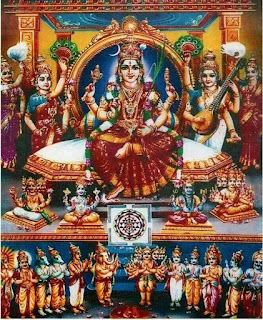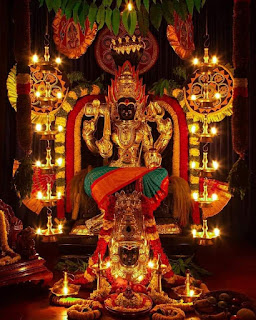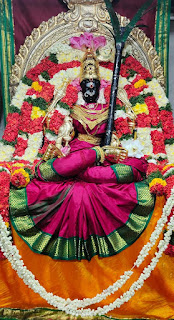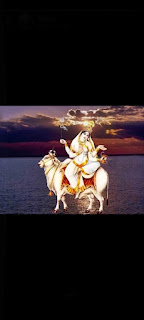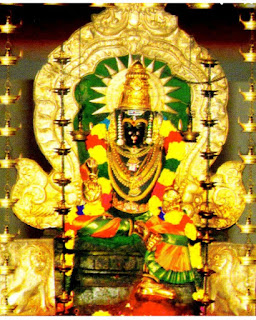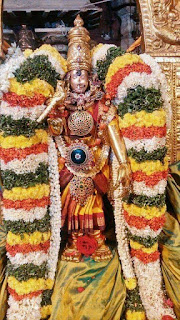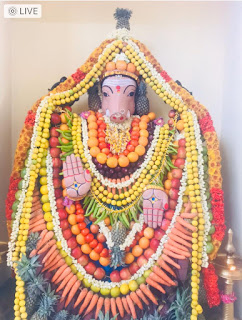शाश्वती (951)
Sasvathi
She's eternal . She's worshiped again and again.
शाश्वतैश्वर्या (952)
Sasvataiswarya
She's the embodiment of eternal wealth, the wealth of knowledge and prosperity.
शर्मदा (953)
Sarmada
The bliss of joy and comfort that She gives is eternal.
शम्भुमोहिनी (954)
Sambu-mohini
She entices Lord Shambu (Lord Shiva), Her consort.
धरा (955)
Dhara
She's in the form of Earth , Prakriti.
धरसुता (956)
Dhara-Sutha
Sutha means daughter. She's the daughter of Himavan, the king of mount ains.
धन्या (957)
Dhanya
She's the possessor of wealth and prosperity. She bestows them on Her devotees.
धर्मिणी (958)
Dharmini
She's said to be in the form of Dharma
धर्मवर्धिनी (959)
Dharma-vardhini
She removes deceptive nature and increases righteousness in the minds of Her devotees.
लोकातीता (960)
Lokatita
She transcends all worlds, Indra loka, Brahma loka and Vishnu loka and lives with Shiva in Maha Kailasha.
गुणातीता (961)
Gunatita
She's beyond attributes or guna-s, namely Sattva , rajas and tamas
सर्वातीता (962)
Sarvatita
She transcends entirety which means She's the Supreme.
शमात्मिका (963)
Samatmika
Sama means Tranquillity that's attained through intense meditation. Tranquillity is Her nature.
बन्धूककुसुमप्रख्या (964)
Bhandhuka-kusumaprakkhya
Bhandhuka is a tree whose flower is yellowish red in colour and is very bright and tender. She is compared to this flower.
बाला (965)
Bala
She's known as Bala in Her manifestation as a young girl of nine years.
लीलाविनोदिनी (966)
Lila-vinodini
Lila means Her three primary actions of creation, sustenance and dissolution, which is like a act of play for Her.
सुमङ्गली (967)
Sumangali
Mangala means anything auspicious. Su means possession of supremacy. Therefore she's the embodiment of supreme auspiciousness.
सुखकरी (968)
Sukhakari
She gives happiness.
सुवेषाढ्या (969)
Suveshadhya
She's is very attractive and beautifully adorned with rich ornaments and garments.
सुवासिनी (970)
Suvasini
A woman who is auspiciously dressed and lives with her spouse is called Suvasini.
She's the embodiment of all such good qualities.
सुवासिन्यर्चनप्रीता (971)
Suvasinyarchana-pritha
She's highly pleased when she's worshiped by Suvasini-s.
आशोभना (972)
Aashobana
The alphabet Aa strengthens the word Shobana. Shobana means beautiful, Aashobana means extremely beautiful.
शुद्धमानसा (973)
Suddhamanasa
She's pure minded.
बिन्दुतर्पणसन्तुष्टा (974)
Bindu-tarpana-santushta
She's happy if offerings are made in the Bindu, the center point of Srichakra. Offering special argya on the Bindu is called tarpana.
पूर्वजा (975)
Purvaja
She exists even before creation. Shiva created Her and She created the universe.
त्रिपुराम्बिका (976)
Tripurambika
Tripurambika means mother of triads, creation, sustenance and dissolution.
Tripurambika is the presiding deity of the inner most triangle of Srichakra , in the midst of which the Bindu is placed. The three lines of the triangle represent all that is in the form of triads. Each corner of the triangle is guarded by Vama, Vajreswari and Bhagamalini, the three important deities of Srichakra. All the triads unite into a single Bindu.
दशमुद्रासमाराध्या (977)
Dasamudra-Samaradhya
She's worshiped through ten types of finger gestures known as mudras.sarva sa~NkShobhini, sarvavidrAvinI, sarvAkarshini, sarvavashankari, sarvonmAdinI, sarvamahankusha, sarvakhechari, sarva bIja, sarva yoni, sarva trikhaNDA) Samaradhana means worship.
त्रिपुराश्रीवशङ्करी (978)
Tripura-Srivasamkari
Tripurasri is the name of the presiding deity of the fifth avarana of Srichakra, which is known as the accomplisher of all objects. Tripurasri is part of Lalithambika and she's worshiped by the vac-devis before revealing Lalithambika in the last nama.
ज्ञानमुद्रा (979)
Jnanamudra
This mudra, also known as Chin mudra, is made by connecting the tips of the index and thumb fingers, by keeping the other fingers stretched. It indicates the union of jivatma with paramatma. This nama calls Her gnanamudra as She's the embodiment of knowledge.
ज्ञानगम्या (980)
Jnana -gamya
Gamya means approacheable. She's approacheable only through knowledge.
ज्ञानज्ञेयस्वरूपिणी (981)
Jnana-jneya-svaroopini
She's the knowledge and the known.
योनिमुद्रा (982)
Yoni-mudra
Yoni is the typical symbol of the divine procreative energy and is the ninth mudra of the dasa mudras discussed earlier. She's in the form of Yoni mudra.
त्रिखण्डेशी (983)
Trikhandesi
Trikhannda mudra, also known as Brahma mudra, is the tenth mudra. It means the merger of various triads into a single entity.
त्रिगुणा (984)
Tri-guna
She's in the form of three guna-s, Sattvic, rajas and tamas.
अम्बा (985)
Amba
This is an interjectory statement. The practitioner gets excited here and reaches a stage that is very close to ecstasy. Amba means mother.
त्रिकोणगा (986)
Trikonaga
Trikona means triangle. This nama means that she resides in a triangle. The inner most triangle of Srichakra, also known as Sarva-sidhi-Prada chakra.
अनघा (987)
Anaga
Agha means sin, impurity, suffering, etc. This nama says she's devoid of these qualities.
अद्भुतचारित्रा (988)
Adbhuta-caritra
Adbhuta means extraordinary, supernatural, wonderful ,marvellous and caritra conduct, behavior, manner of acting, etc. This nama says Her behavior is supernatural and wonderful.
वाञ्छितार्थप्रदायिनी (989)
Vanchitartha-pradayini
She gives whatever is prayed for, by Her devotees.
अभ्यासातिशयज्ञाता (990)
Abhyasatisaya-jnata
Abhyas means "to concentrate". Atisaya means pre-eminent, superior, abundant ,etc and jnata means to know or to comprehend. This nama says that one should practice continuously to focus his entire attention to know Her supreme qualities.
षडध्वातीतरूपिणी (991)
Sadadhvatita-rupini
There are six types of worship, pada, Bhuvana, varna, tattva, kala and mantra. In order to attain Her, one has to meditate on Srichakra using these six methods of worship.
अव्याजकरुणामूर्तिः (992)
Avyaja-karuna-murtih
She's compassionate to everyone without bias.
अज्ञानध्वान्तदीपिका (993)
Ajnana-dhvanta-deepika
She's the lamp that dispels the darkness of ignorance.
आबालगोपविदिता (994)
Aabala-gopa-vidita
She's perceived and understood even by children and cowherds ,who do not have spiritual knowledge.
सर्वानुल्लङ्घ्यशासना (995)
Sarvanullanghya-sasana
Her commands are never disobeyed.
श्रीचक्रराजनिलया (996)
Srichakra-Raja-nilaya
She abides in Srichakra, which is also known as Sriyantra. This is the supreme amongst all yantras.
श्रीमत्त्रिपुरसुन्दरी (997)
Srimat-Tripura-sundari
Shiva is known as Tripura Sundara and His consort is Tripura Sundari. Tri means three and pura means fortress, castle, etc. This refers to the three unique acts of creation, sustenance and dissolution.
श्रीशिवा (998)
Sri Shiva
Shiva means purity of the highest order. Shiva also means liberation. She's most auspicious and divine Shiva.
शिवशक्तैक्यरूपिणी (999)
Siva-Sakty-aikya-rupini
This is the most revered, admired, perplexed , incomprehensible and secretive form of the divine couple , the confluence of Siva and Sakthi. The universe is created, sustained and dissolved and re-created by them at their will that is indentured by the law of karma.
ललिताम्बिका (1000)
Lalithambika
Srimata, thy name is Lalithambika_
_She's the supreme mother, she's the Brahman. She's the embodiment of compassion, yet she's tough at times and punishes the guilty. She can be attained only through pure and unstinted devotion, without which one cannot go anywhere near her.
She's everything and everything is created, sustained and dissolved by Her.
This completes the interpretation on Her one thousand auspicious namas that is now placed at Her sanctifying lotus feet praying for all round happiness, prosperity and peaceful co-existence.





